Tuna pesto pasta is an easy comfort food recipe made with canned tuna, pesto and your favorite noodles. It’s simple, flavorful and perfect for make-ahead meals or weeknight dinners.
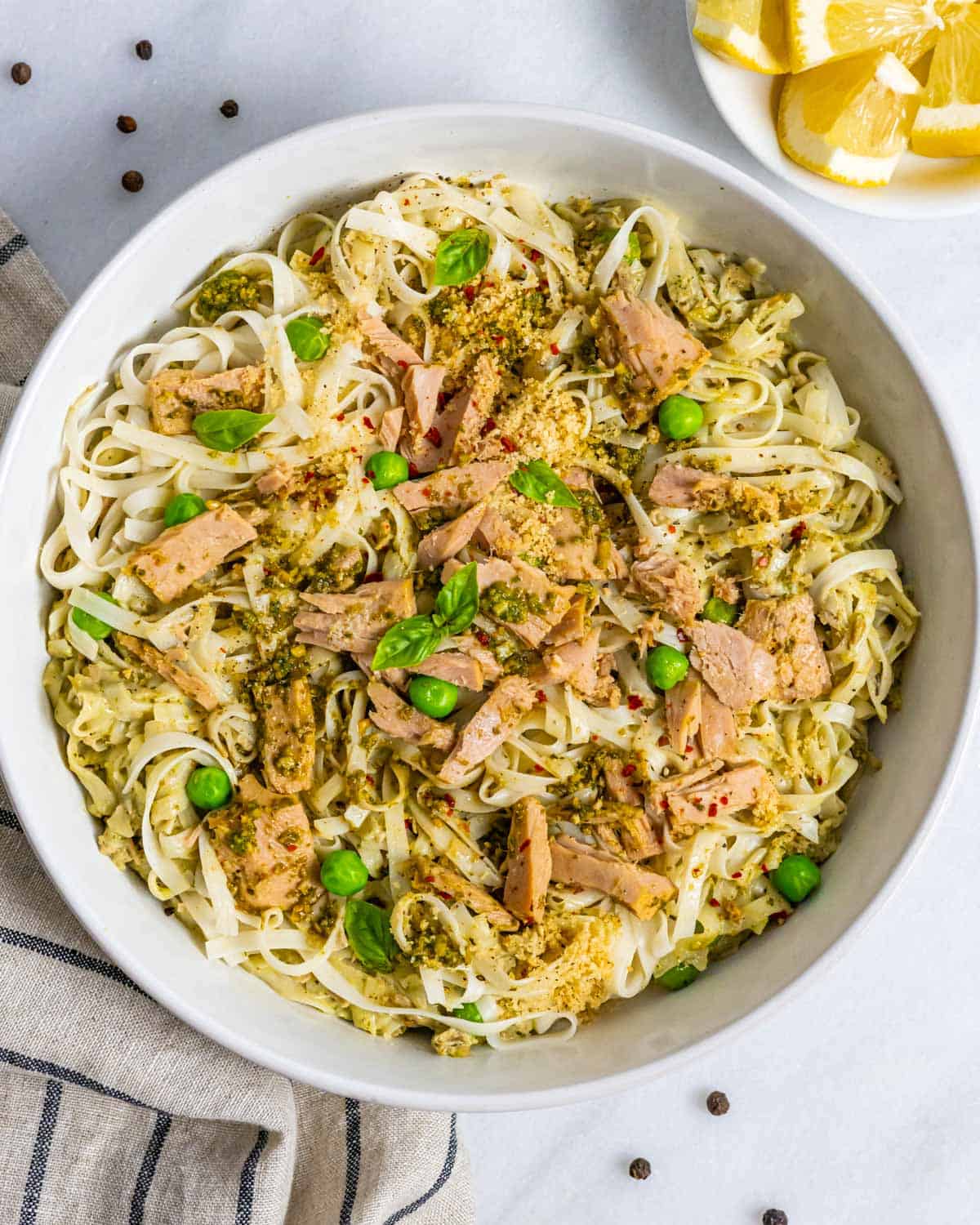
Jump to:
Who doesn’t love retro recipes, especially those that conjure up memories of creamy, old fashioned tuna noodle casserole? This dish is a marriage of creamy tuna pasta and tuna carbonara. It can be served as a warm or cold pasta and makes a quick meal, ready in under 20 minutes, like this luxurious Marry Me Chicken Pasta. But if you find yourself looking for other quick and amazing canned tuna recipes, definitely check out this delicious Miso Tuna Salad, or this Asian Tuna Salad, which is one my most popular recipes.
Canned tuna may seem like an odd ingredient to add to pasta with peas, but it really makes an amazing comfort food meal for any time of year. This recipe is just so, so good.
Why you’ll love this recipe
- Easy, fast and healthy – perfect for weeknight meals or quick lunches
- Make-ahead meals are a snap – makes amazing leftovers
- Uses minimal ingredients and pantry staples – you can probably toss this together with ingredients you already have
- It’s nostalgic food – but with a few modern twists. No canned cream of mushroom soup here!
- Use your favorite pasta – shirataki noodles, zucchini noodles, gluten-free pasta or even spaghetti are all great options
- Special diet friendly – this is a delicious recipe for keto, low-FODMAP, paleo, AIP and Whole30 diets
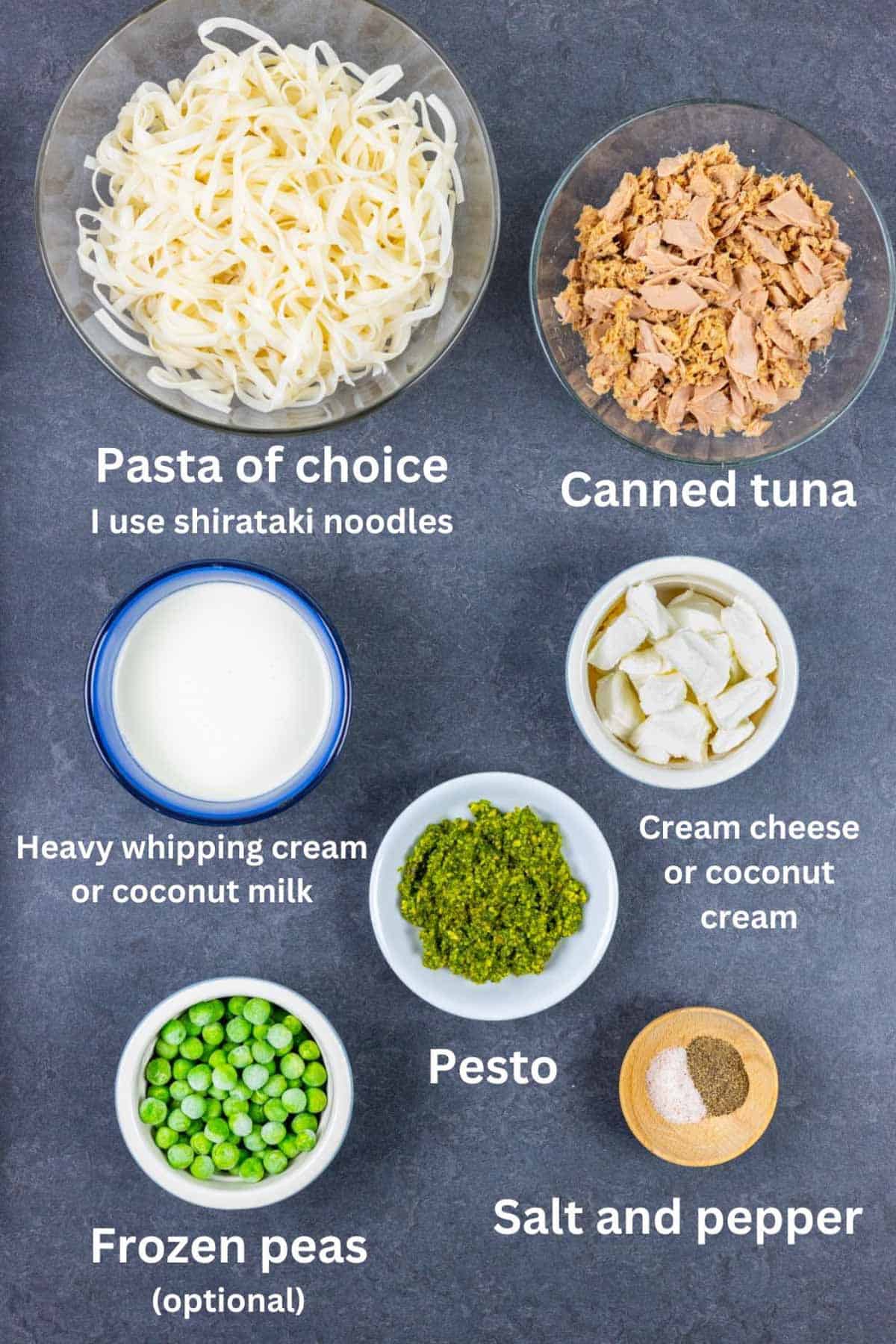
Ingredients
This simple recipe comes together with a handful of pantry staples:
- Pasta – see these recommendations for the best pasta to use
- Tuna – any canned salted or unsalted tuna will work well. Read more about varieties of canned tuna below.
- Frozen peas – are optional, but add sweetness and color. They're keto-friendly when consumed in small quantities. Use caution with low-FODMAP, as they tend to by high in GOS and fructans. Canned peas may be a better option.
- Heavy whipping cream – makes a savory, creamy sauce. For a dairy-free pasta sauce, see the instructions for making this dish AIP friendly, and recipe variations for substitutes.
- Cream cheese – makes an extra creamy sauce. Omit for dairy-free and use the same options you'd use for replacing the heavy whipping cream.
- Pesto – there are many types of pesto that work well. I prefer to use Homemade Basil Pesto, but any store-bought pesto sauce will work well, too.
- Salt and pepper – to taste
Note on cream for low-FODMAP: Heavy whipping cream and cream cheese are high-fat dairy and low in FODMAPs. The serving sizes in this recipe are below the recommended serving for lactose.
Are peas low-FODMAP?
Frozen peas are high in galacto-oligosaccharides (GOS) and fructans in servings above ⅛ cup (2 tablespoons). A one tablespoon serving is considered a FODMAP-friendly portion.
Canned peas will have a lower FODMAP content and are considered low-FODMAP in ¼ cup servings. If you choose to use canned peas in this recipe, add them at the very end so they are less likely to get mushy when stirred into the pasta.
If you want to avoid FODMAPs in peas altogether, use FODMAP-friendly options like spinach, roasted red peppers or tomatoes.
Best canned tuna
What is the best canned tuna to use for canned tuna pasta recipes? The variety you use is up to you. Tuna in water or olive oil both work well. Tuna in oil will have a richer, more savory flavor, where tuna in water will taste a bit lighter.
I like to use a tuna that’s a little darker in color for this recipe, such as tongol, yellowtail or skipjack. However, albacore ‘solid white’ tuna is also a fine option. I use a darker colored fish for aesthetic purposes only. I think it has a nice contrast with the noodles.
What is the best pasta to use?
You can make this recipe to suit your taste and use your favorite style. While I prefer linguine, fettuccini or spaghetti-style noodles, you can use penne, bow-tie, rotini or other fun shapes. These are great if you’re making this for a family gathering or as a potluck side dish. Really, anything goes!
Pasta ideas for special diets
Keto-friendly pasta – there are a few great options for keto pasta noodles. My favorite to use is fettuccine shirataki noodles. Or, consider keto pasta substitutes like spiralized zucchini, hearts of palm linguine or cabbage noodles.
Low-FODMAP pasta – wheat noodles are considered high-FODMAP, so choosing a gluten-free option is best, especially during the elimination phase of the diet. Shirataki noodles are a low-carb pasta that are great for a low-FODMAP diet, as are hearts of palm and spiralized vegetables, like zucchini. If you aren’t following a low-carb diet, there are tasty options that contain quinoa, corn, rice, cassava and millet. It’s best to avoid pasta with lupin or soy flour, as those are typically rich in FODMAPs.
Instructions
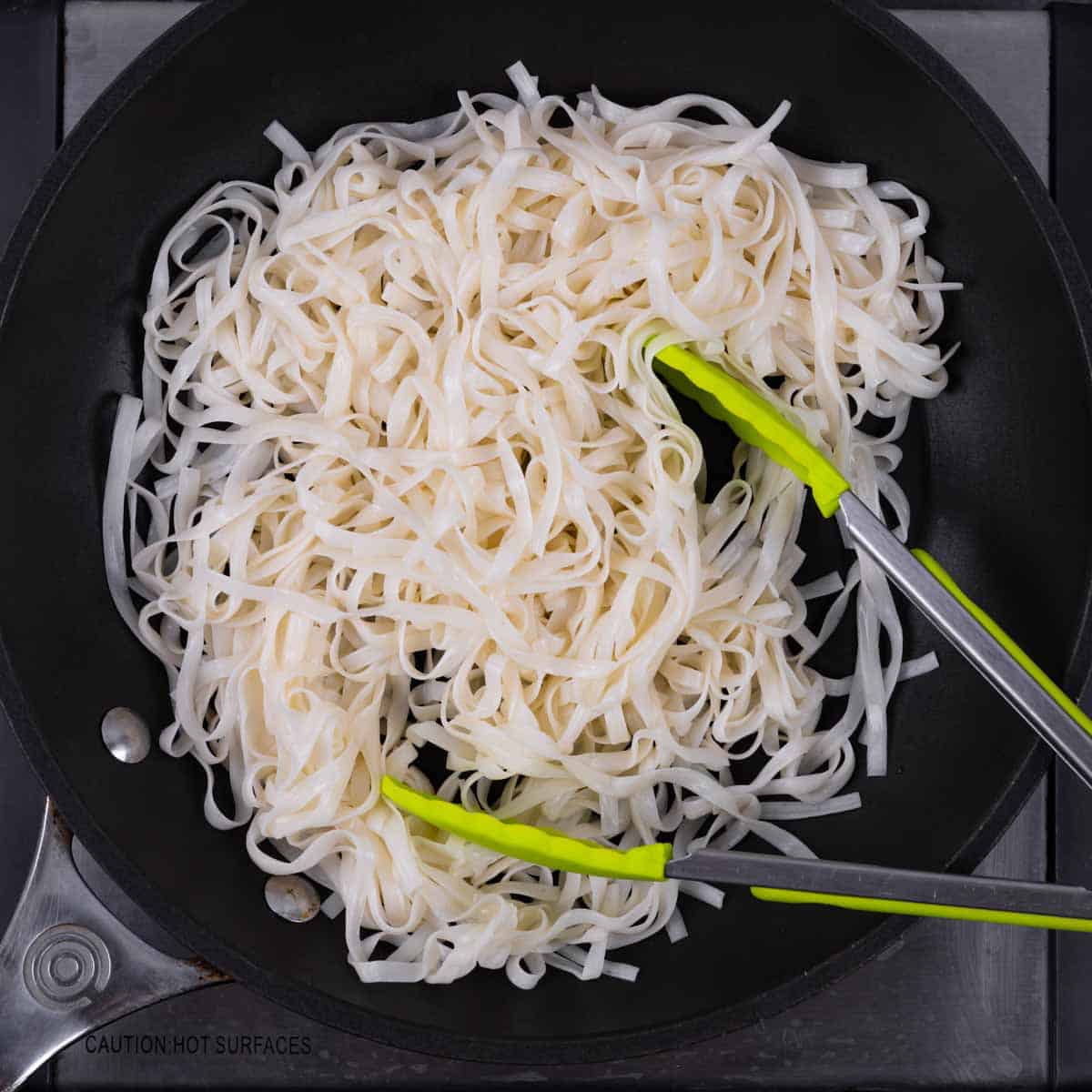
Prepare the pasta according to package instructions or make veggie noodles with a spiralizer. I use shirataki fettuccini, which calls for straining the noodles, then lightly sauteeing them to remove excess moisture.
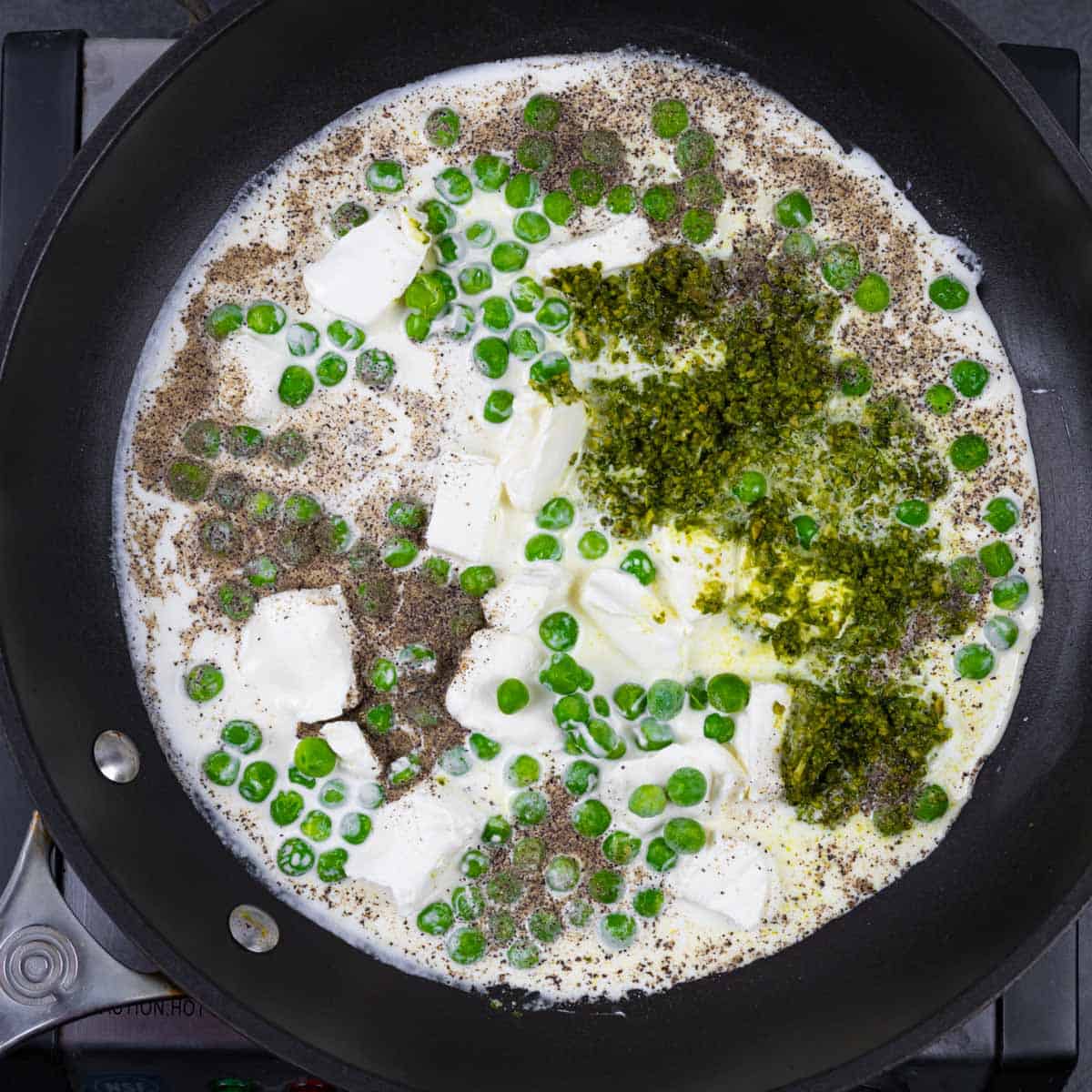
In a large skillet, add the cream, cream cheese, peas and half of the pesto. Heat to a simmer and cook until peas are tender, about 2 minutes.
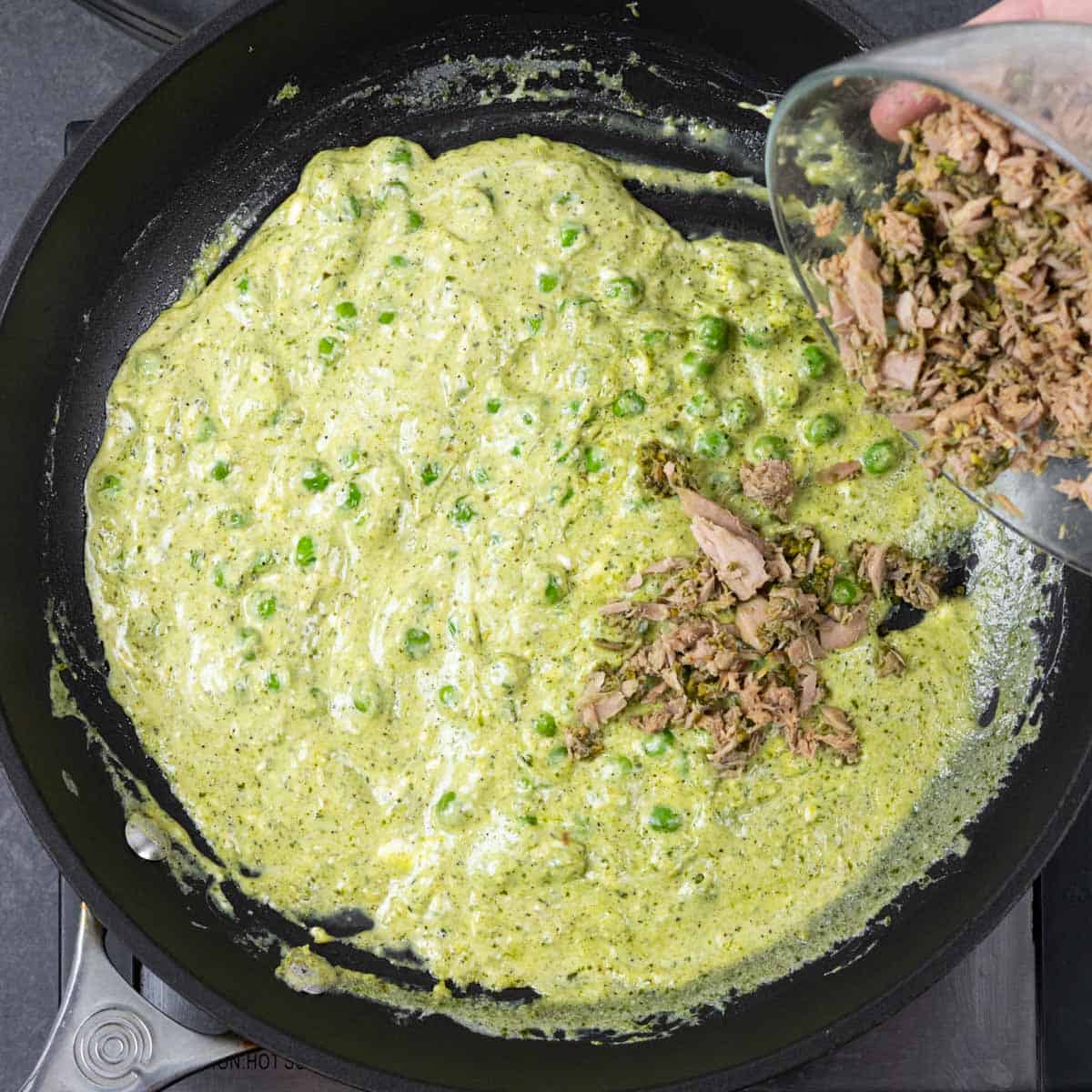
Drain 1 can of tuna, add it to the skillet and mix well.
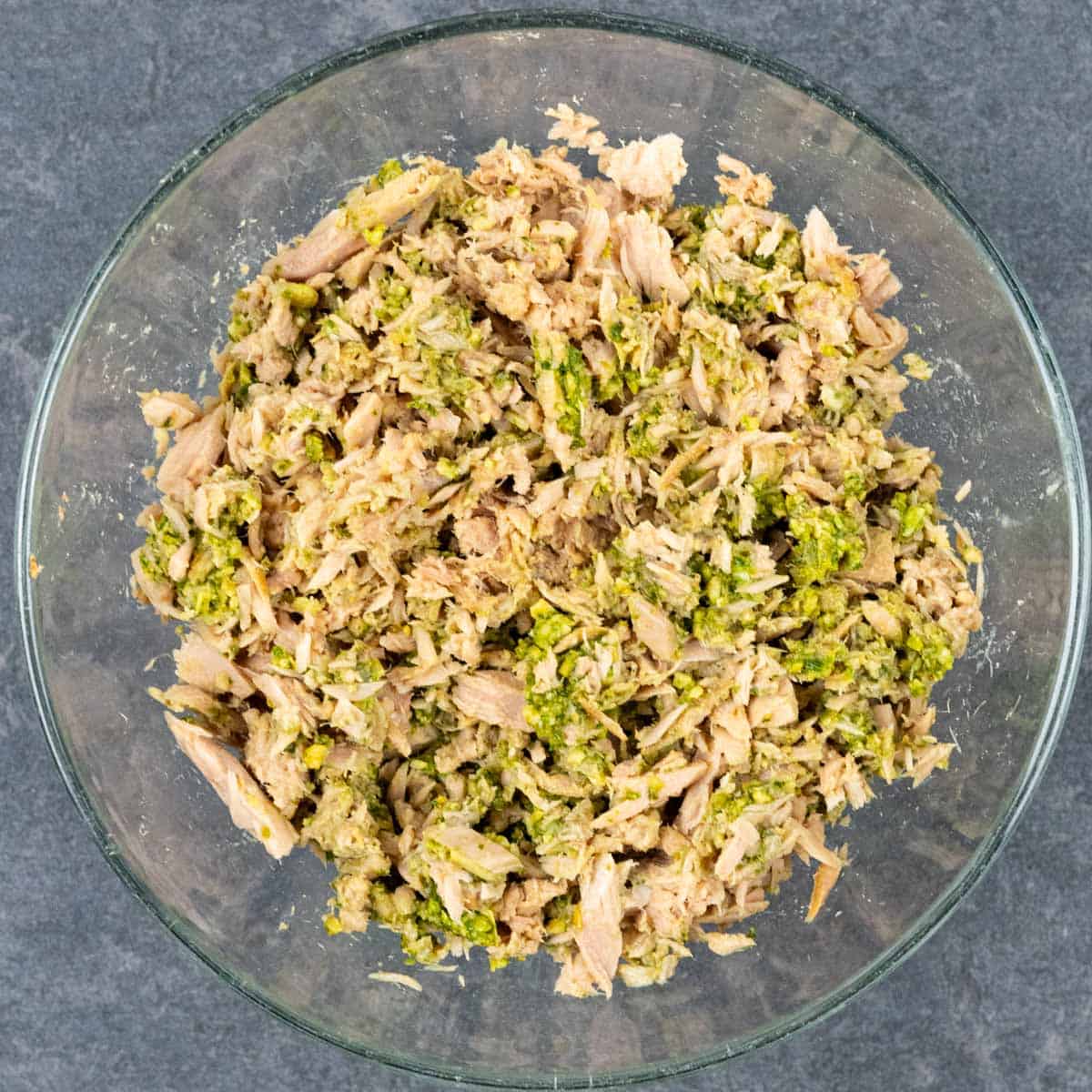
In a bowl, combine the second can of drained tuna and the rest of the pesto and mix together.
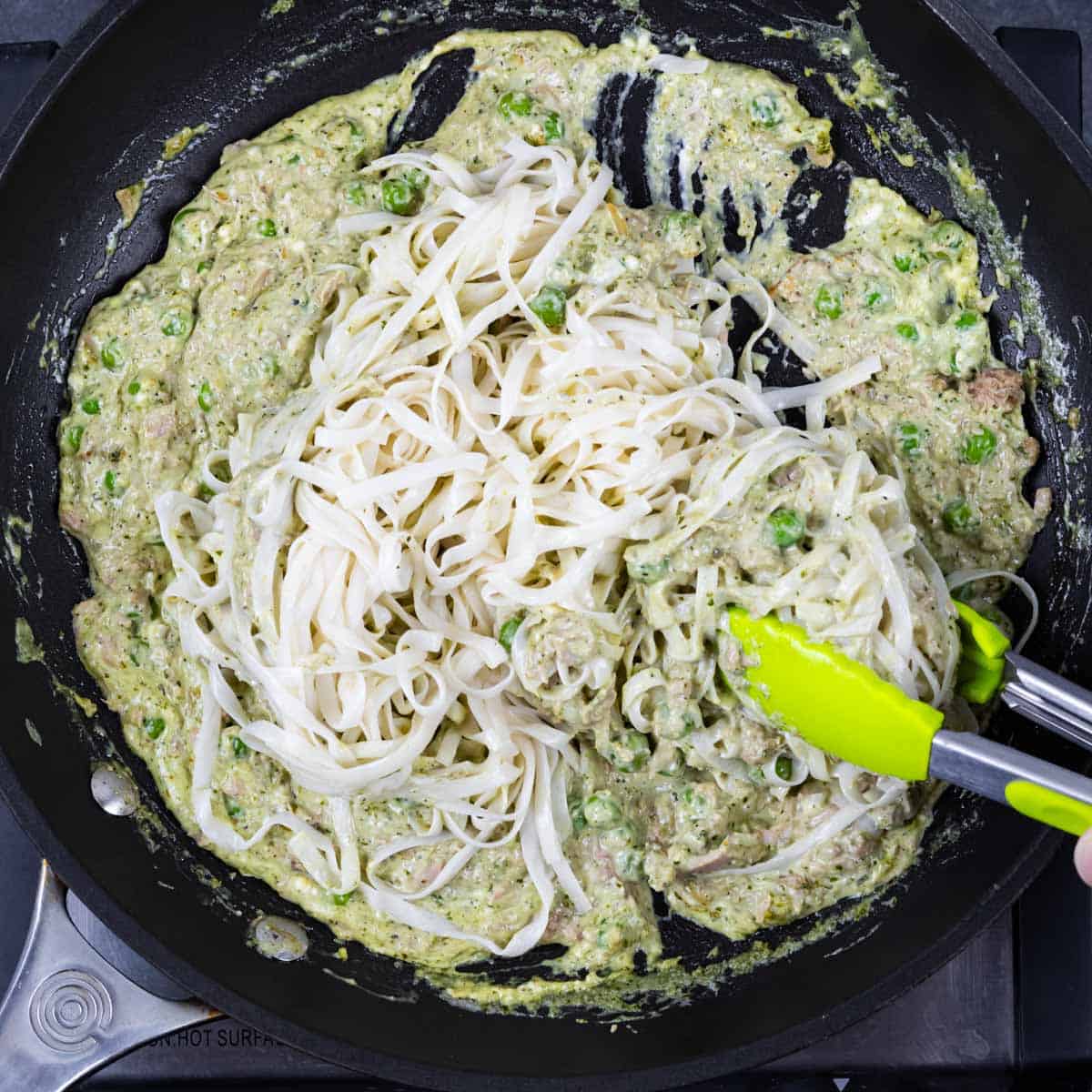
Add the noodles to the skillet and gently mix until the noodles are covered with the cream sauce.

Gently fold in the tuna and pesto from the bowl.
TIP: Adding the tuna and pesto two different ways creates a layering of flavors and textures to the dish.
Making an AIP pasta
AIP tuna pesto pasta is amazingly good and totally compliant for the autoimmune protocol. You’ll definitely want to check out the AIP variation in my Homemade Basil Pesto recipe for this.
AIP pasta options include the low-carb and veggie noodle options for a keto diet above, as well as fabulous cassava noodles!
The instructions are so easy:
- Prepare the pasta
- Combine the tuna and pesto
- Stir in the noodles, add more olive oil and salt as needed
Add-ins: a sprinkle of nutritional yeast, sautéed garlic, shallot or onion, leafy vegetables such as arugula or spinach. See below for additional add-in ideas.
Variations
This recipe is very versatile and easily customizable:
- Use a tuna substitute – swap out the tuna for shrimp or canned or grilled salmon and create a salmon pesto pasta. Or, you can use chicken as a stellar fish substitute.
- Use rice instead of noodles – make this dish with homemade cauliflower rice, shirataki rice, regular rice or even quinoa if you don’t follow a low-carb diet
- Replace the pesto – if you don’t have basil pesto, try using Mexican Chimichurri
- Make it dairy-free – replace the cream and cream cheese with coconut milk or homemade broth and coconut cream. Or, follow the AIP instructions, above.
- Serve as a side – prepare the pasta without the tuna and serve as a side with your favorite protein
Optional add-ins
There are several options to add more flavor and color to your dish:
- Oyster mushrooms and leek – these are great FODMAP-friendly options. Sautee in oil in the skillet before adding the cream and other ingredients
- Bacon – because bacon is good with just about everything
- Add more vegetables – garlic, shallot or onion (not for low-FODMAP), roasted red peppers, sundried tomatoes, asparagus, spinach, mushrooms, capers or olives
How to store
Store any leftovers in a sealed container in the refrigerator for up to 3 days.
Freezing will depend on the variety of pasta you use. Shirataki and spiralized vegetable noodles won’t easily hold up to freezing.
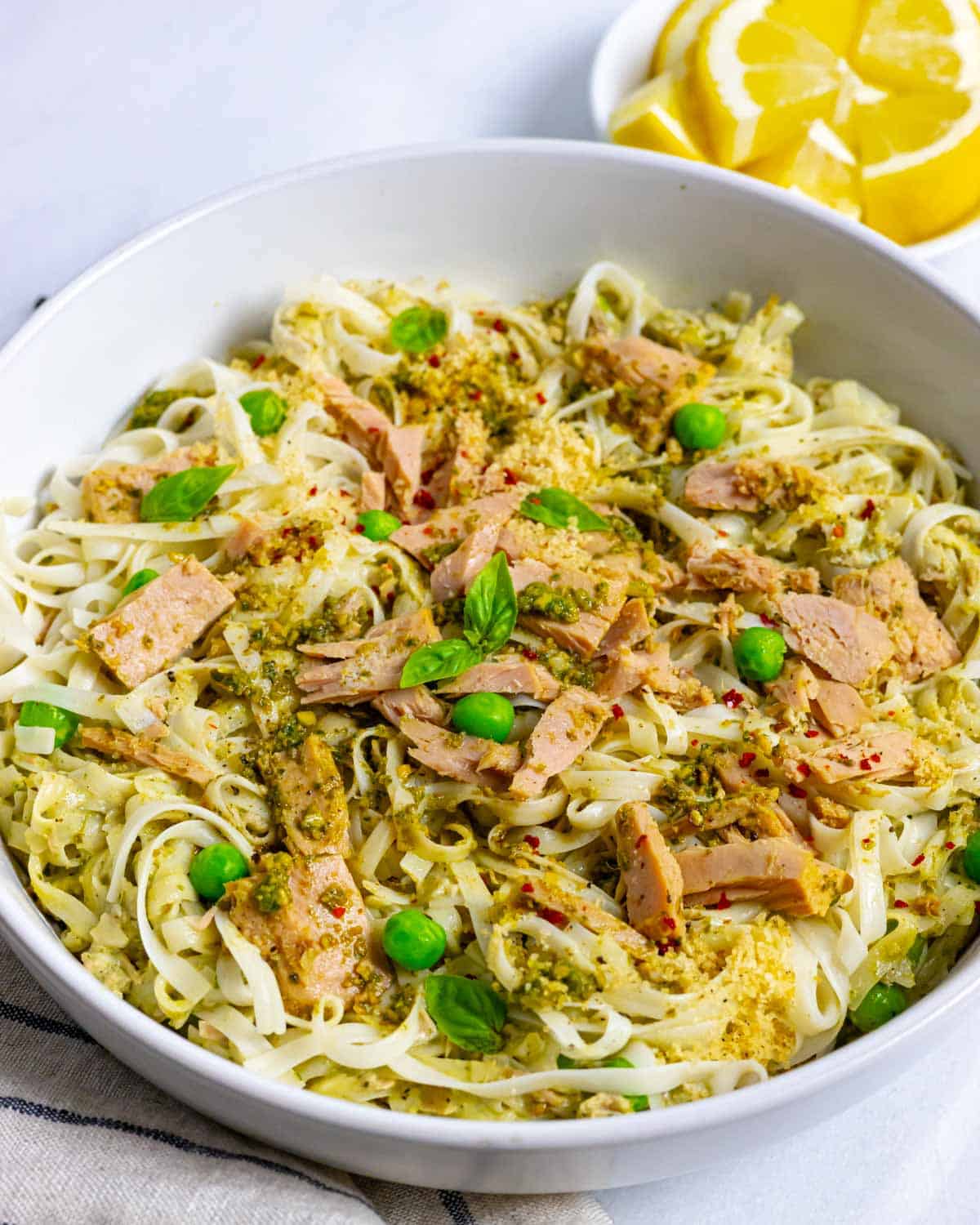
How to serve
Here are a few of my favorite toppings to add when serving:
- Grated parmesan – because parmesan just belongs with pasta
- Crumbled pork rinds – these are a wonderful replacement for breadcrumbs
- Coarsely ground pepper – for a little earthy spiciness and texture
- Red pepper flakes or Aleppo pepper flakes – lends just a little spice and heat. Read more about Aleppo pepper in my Aleppo Pepper Ingredient Spotlight.
- A drizzle of pesto thinned with olive oil – for more pesto flavor and garnish
- Sprinkle with nutritional yeast – for a cheesy flavor, without the cheese
- Lemon zest or fresh squeezed lemon – adds brightness and a little citrus tanginess
FAQ
The flavor compliments most meat, poultry and seafood. Serve it with steak, chicken, pork chops or tenderloin, fish fillets or lamb chops.
Yes - it's is high in protein and very low in carbs, making it a perfect addition to a keto diet.
It should last 3-4 days in the refrigerator when stored in a covered container.
It is possible for it to go bad. Canned fish has a very long shelf-life and can last for several years with proper storage, even past its expiration date. However, cans that have not been sealed properly or have damage can cause the fish to spoil. Always inspect for signs of spoilage when opening the can, such as an off odor or color, mold or unusual appearance.
Yes. Fish and seafood are proteins and do not contain carbohydrates, making them free of FODMAPs. Be sure to read the ingredient label and avoid products with added high-FODMAP ingredients such as garlic and onion.
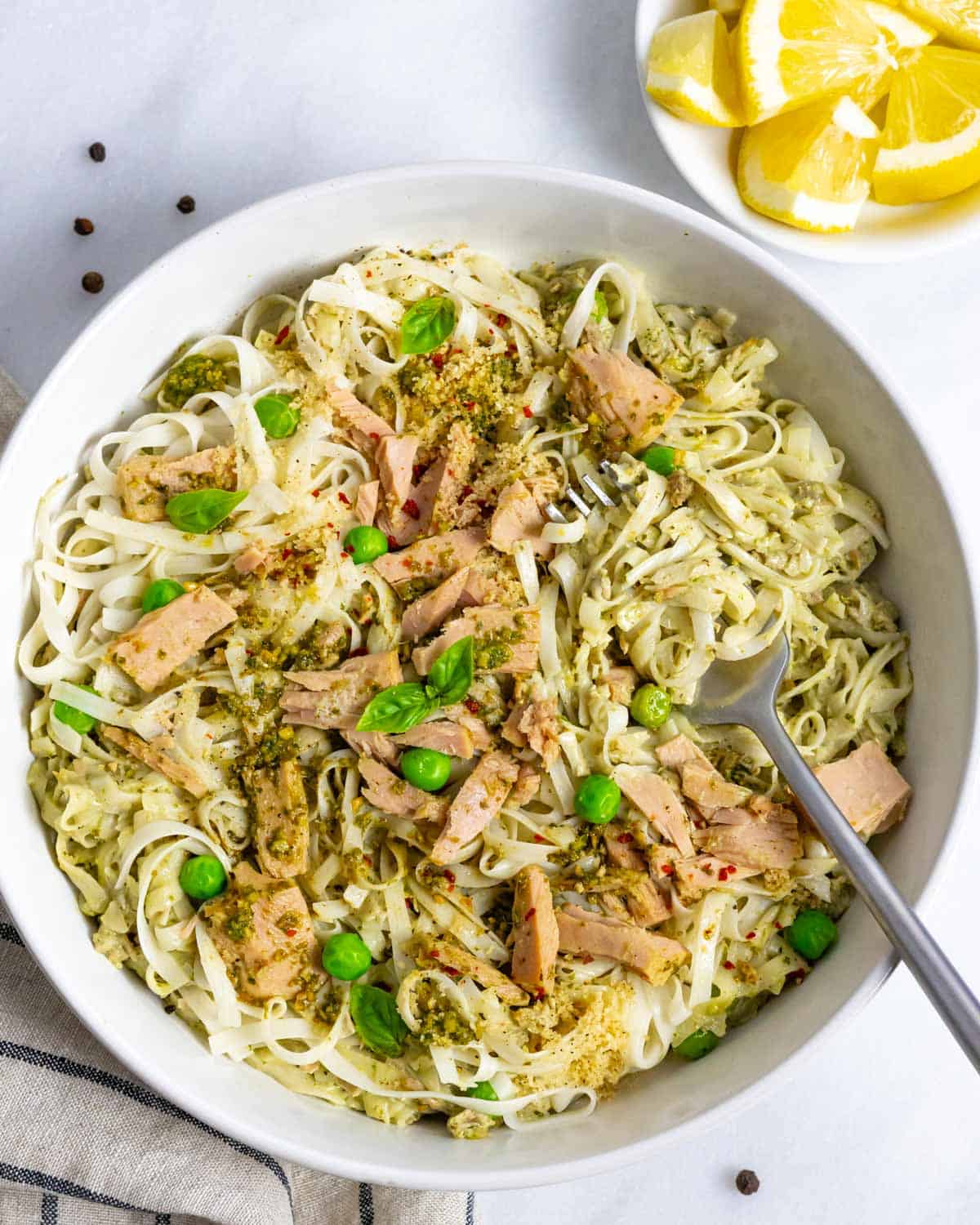
Did you make this recipe? Let me know how you liked it by giving a star rating and leaving a comment!
📖 Recipe
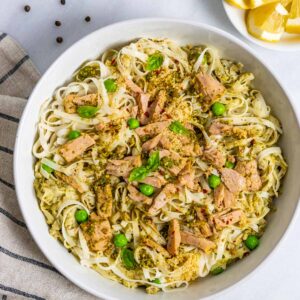
Tuna Pesto Pasta
Ingredients
- 12 ounces pasta (I use two packages of shirataki pasta)
- 2 cans tuna (drained)
- ½ cup frozen peas (optional for low-FODMAP)
- ½ cup heavy whipping cream (or full fat coconut milk or homemade bone broth)
- 3 ounces cream cheese (or coconut cream)
- 6 tablespoons pesto (I use Homemade Basil Pesto)
- ½ teaspoon salt
- ½ teaspoon pepper
Instructions
- Prepare the pasta according to package instructions or make veggie noodles with a spiralizer. I use shirataki noodles, which calls for straining the noodles, then lightly sauteeing them to remove excess moisture.
- In a large skillet, add the cream, cream cheese, peas and half the pesto.
- Heat to a simmer and cook until peas are tender, about 2 minutes.
- Add 1 can of drained tuna and mix well.
- In a bowl, combine the other can of tuna (drained) and the rest of the pesto and mix.
- Add the noodles to the skillet and gently mix until the noodles are covered in creamy sauce.
- Gently fold in the tuna and pesto from the bowl.
Notes
Note for low-FODMAP
Heavy whipping cream and cream cheese are high-fat dairy and low in FODMAPs. The serving sizes in this recipe are below the recommended serving for lactose. Frozen peas are high in galacto-oligosaccharides (GOS) and fructans in servings above ⅛ cup (2 tablespoons). A one tablespoon serving is considered a FODMAP-friendly portion. Canned peas will have a lower FODMAP content and are considered low-FODMAP in ¼ cup servings. If you choose to use canned peas in this recipe, add them at the very end so they are less likely to get mushy when stirred into the pasta. If you want to avoid FODMAPs in peas altogether, use FODMAP-friendly options like spinach, roasted red peppers or tomatoes.Variations
- Use a tuna substitute – swap out the tuna for shrimp or canned or grilled salmon and create a salmon pesto pasta. Or, you can use chicken as a stellar fish substitute.
- Use rice instead of pasta – make this dish with homemade cauliflower rice, shirataki rice or regular rice or even quinoa if you don’t follow a low-carb diet
- Replace the pesto – if you don’t have basil pesto, try using Mexican Chimichurri
- Make it dairy-free – replace the cream and cream cheese with coconut milk or homemade broth and coconut cream. Or, follow my AIP instructions.
How to serve
- Grated parmesan – because parmesan just belongs with pasta
- Crumbled pork rinds – these are a wonderful replacement for breadcrumbs
- Coarsely ground pepper – for a little earthy spiciness and texture
- Red pepper flakes or Aleppo pepper flakes – lends just a little spice and heat
- A drizzle of pesto thinned with olive oil – for more pesto flavor and garnish
- Sprinkle with nutritional yeast – for a cheesy flavor, without the cheese
- Lemon zest or fresh squeezed lemon – adds a brightness
Nutrition
*Net carbs = carbohydrates - fiber
Nutritional information is an estimate, calculated using online tools and does not include optional ingredients unless otherwise indicated.

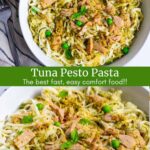

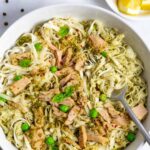
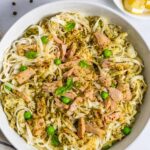
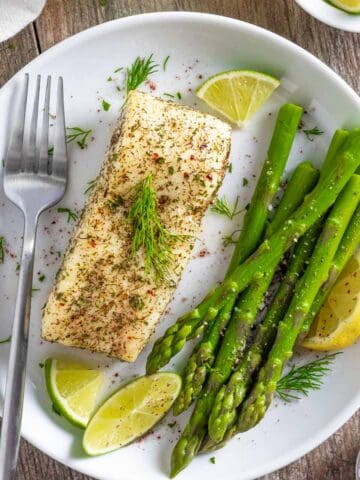
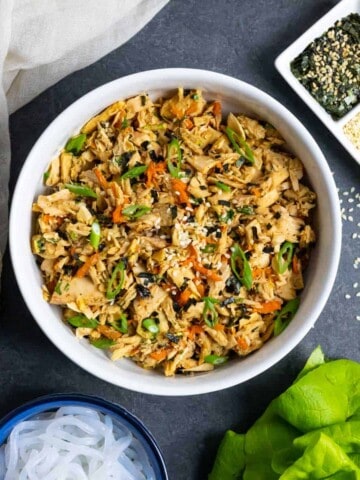
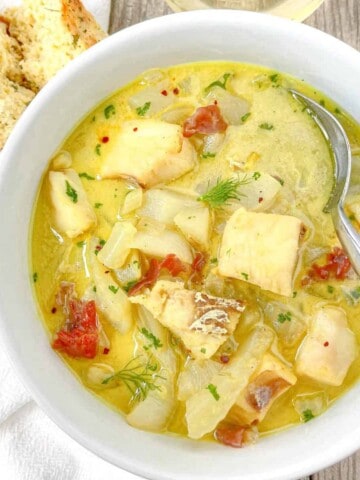

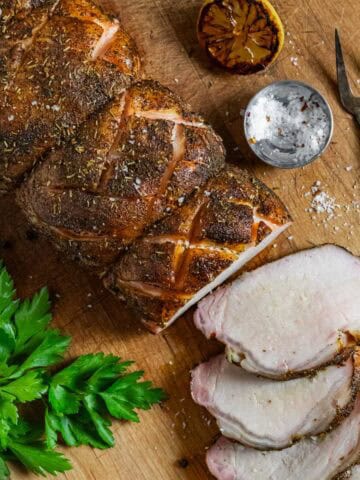
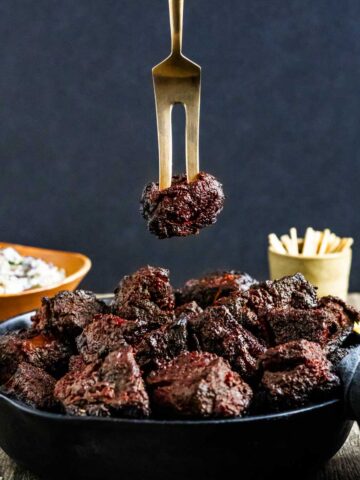
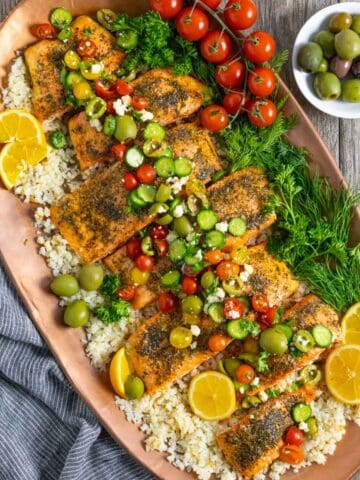
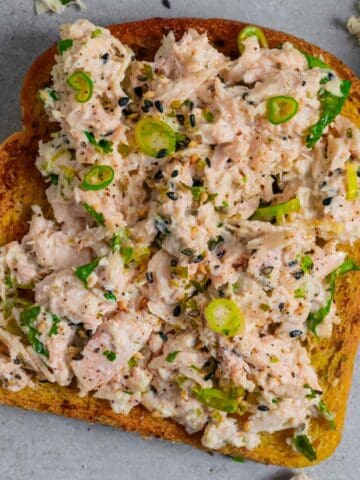
Katie says
I work from home and made this on my lunch break with konjac noodles. The sauce was perfectly creamy - like tuna casserole, but better!
Tracey Hatch-Rizzi says
Hi Katie,
I'm so glad you liked the recipe! I love konjac noodles, especially with a creamy sauce!
Best,
Tracey